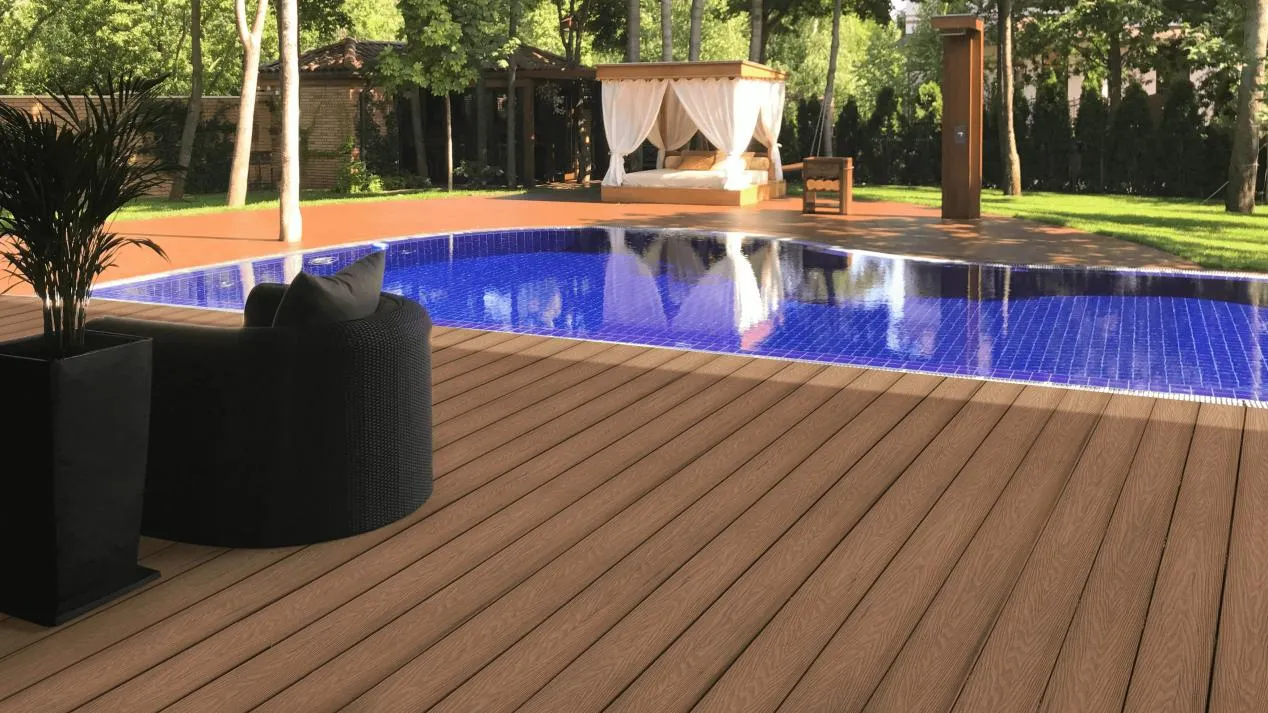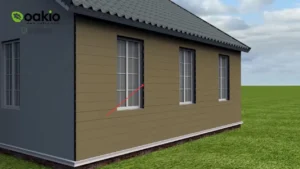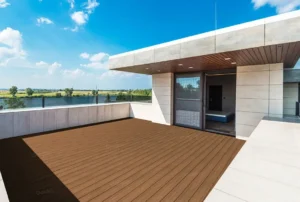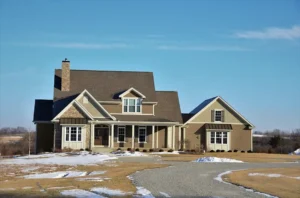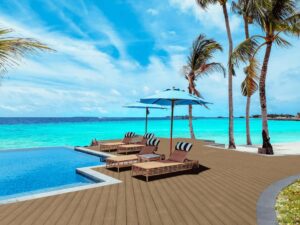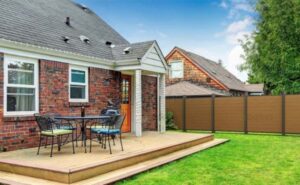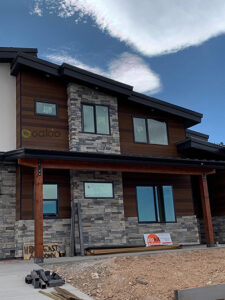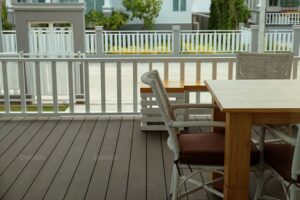The Science Behind Wood Plastic Composites
What are WPCs? Wood plastic composites (WPCs) are a type of hybrid material composed of two different compound materials: wood fibers and thermoplastics or recycled plastics. They were developed as a sustainable alternative to traditional wood and plastic and as eco-friendly building materials.
Today, WPCs hold significant importance in materials science because of their modern, durable, eco-friendly, and weather-resistant qualities. Apart from decking, WPCs are now widely used in other industries, offering a cost-effective solution that balances durability and aesthetics.
In this article, we will delve deep into the science of wood-plastic composites and share with you just how and why WPCs are at the forefront of modern material science and how they shape the industries around us.

Composition of Wood Plastic Composites
Components of WPCs
If you have ever wondered how are WPCs made, it’s actually simple: they’re made by combining two materials together to form a hybrid material. Wooden fibers and plastic polymer materials are combined with the fibers adding strength and the feel and texture of real wood.
The fibers are then infused with thermoplastics, such as polyethylene (PE), polypropylene (PP), or polyvinyl chloride (PVC), which binds the fibers together, significantly improving the material’s durability.
Types of Plastics Used
Different types of plastics offer different properties to WPCs:
- Polypropylene (PP): Known for its high melting point, PP enhances the heat resistance and structural integrity features of WPCs. PP is lightweight, making it a good choice for automotive and lightweight furniture usage.
- Polyethylene (PE): Commonly used for its low price and flexibility, PE provides top-notch moisture resistance and durability, and is often favored for outdoor decking, fencing, and screening applications.
- Polyvinyl Chloride (PVC): PVC offers excellent strength, weather resistance, and fire resistance. Its durability and rigidity allow it to handle extreme weather, making it ideal for construction and cladding applications.
The Manufacturing Process of WPCs
Overview of Production Methods
The production of WPCs begins by carefully blending and mixing wood fibers and polymer plastics. Wood fibers are dried thoroughly first to reduce their moisture content (so plastics can adhere better) before being mixed with thermoplastics like PE, PP, or PVC.
The blending process often involves heavy machinery, like a twin-screw extruder to ensure thorough dispersion of the wood fibers. Once mixed, the composite material undergoes a shaping and molding process. There are several shaping processes, each with its purposes.
Extrusion involves heating and forcing the material into a die to form continuous shapes, such as boards. Injection molding involves heating and forcing the material into a static shape, while a method called press molding is used to create large flat panels through heat and pressure.
Additives in WPC Production
Apart from wood fibers and polymer plastics, additives also play a vital role in ensuring the WPCs are durable, aesthetic, and long-lasting:
- Colorants: Colorants enhance the vibrance of the material, improving its aesthetic appeal. They provide a range of colors and textures to mimic natural wood finishes.
- Coupling Agents: Coupling agents improve the adhesion between wood fibers and polymers, enhancing strength and durability.
- Stabilizers: They protect the material from premature UV degradation, thermal stress, and moisture damage—-ensuring the WPC is guaranteed to last long in outdoor applications.
Properties of Wood Plastic Composites
Mechanical Properties
WPCs feature a unique combination of mechanical properties that make them versatile as a construction material. When compared to wood, WPCs offer good strength, and stiffness, and offer resistance to warping, cracking, or splintering.
While not as durable as pure plastics or metal alone, their mechanical durability and flexibility are actually suitable for many structural, construction, and decorative uses, such as decking, fencing, and even furniture making.
The wood fibers enhance the material’s stiffness, while the polymer plastics provide impact resistance, moisture resistance, and even insect resistance—-enabling the material able to withstand demanding wear and tear.
Thermal and Moisture Resistance
WPCs also demonstrate excellent thermal and moisture resistance compared to traditional wood, thanks to the polymers binding to the fibers. However, some poorly made WPCs may display fungal growth and water damage due to prolonged moisture exposure.
Gold-standard WPCs, though not totally waterproof and moisture-proof, can repel fungal growth and can withstand water damage. Their thermal resistance, on the other hand, is also better than most wood options, though the level of resistance varies depending on the type of plastic used (with PP offering better resistance than PE plastics).
Environmental Impact
Are wood plastic composites environmentally friendly? Yes, WPCs are made as a sustainable alternative to traditional materials such as traditional wood and pure plastics. By using recycled plastics and wood fibers, WPC manufacturers reduce their reliance on virgin resources.
Although WPCs aren’t biodegradable, their long service life and recyclability contribute to eco-friendliness standards.

Applications of WPCs
Construction Industry
If you’ve been wondering what are WPCs for years now, let it be known to you: WPCs have been a game-changer in the construction industry for decades now. WPCs shine particularly in outdoor applications, such as decking and fencing. Since they’re weather-resistant, low-maintenance, and aesthetic, they’re also used in railings, claddings, and even roofing elements.,
Unlike traditional wood, WPCs are also resistant to rotting, insects, and excess moisture, making them the ideal material for long-lasting outdoor applications. Additionally, their design and color flexibility enable architects and engineers to create a more personalized solution for either residential or commercial projects.
Automotive Industry
In the automotive industry, WPCs are also used to produce lightweight interior components, such as door panels, dashboards, and seat backs. The wood fibers enhance the rigidity of the WPC, while its lightweight nature contributes to better fuel figures.
Because WPCs are sustainable and low-cost, more and more car manufacturers are using them as they do not pose a risk to the structural and aesthetic integrity of the vehicle.
Consumer Products
Apart from construction and automotive applications, WPCs are also used in consumer products, thanks to their durability and design flexibility. WPCs are used as an alternative to solid wood when making furniture, and they’re also used in producing toys, kitchenware, and other household items.
Advantages of Wood Plastic Composites
Environmental Benefits
Are wood plastic composites sustainable? Yes, WPCs are an environmentally-friendly material, which offers significant benefits in terms of sustainability. This material uses a blend of recycled plastics and wood fibers, which minimizes the need to use virgin resources.
This incorporation of recycled materials reduces the carbon footprint of production. Unlike traditional wood, WPCs also don’t require additional treatments with toxic, nature-degrading chemicals to add rot and insect resistance to the material.
Apart from those, the long-lasting performance of WPCs and their recyclability make them a good choice if sustainability is the top thing on your mind—-making them a responsible, eco-friendly material.
Economic Advantages
Apart from WPCs being environmentally friendly, they’re also a cost-effective alternative to more expensive materials with similar properties. First, during production, the use of recycled materials (such as in the case of WPCs) significantly lowers raw material costs.
The versatility of the material allows manufacturers to create customized shapes, profiles, and designs with minimal waste and minimal power, increasing production efficiency. WPCs are also renowned for their low-maintenance and durable qualities—two things every homeowner wants to have.
Their durability offsets future repair and replacement costs over time, making them a good long-term investment. Apart from that, their lightweight nature makes shipping and installation easier.
With these economic advantages, WPCs are indeed an attractive solution for those seeking a sustainable, and durable, but budget-friendly material option.
Challenges in WPC Development
Material Compatibility Issues
No material on the planet is perfect; everything has pros and cons. In WPCs, material compatibility issues are still a challenging scientific problem. Wood fibers are naturally hydrophilic (water-attracting), while plastics are hydrophobic (water-repelling), which usually leads to poor adhesion and material binding.
This material incompatibility can weaken the material, making it more prone to cracking, warping, and at times delamination (where different layers of the material get torn apart). To address these, coupling agents are usually used to improve adhesion, especially among higher-quality manufacturers like Oakio.
Processing Challenges
Apart from material incompatibility, processing challenges are also rampant. WPC manufacturing involves processing the materials at high temps. Wood fibers can degrade under extreme heat, reducing the strength of the material. Plastics are also temperature-sensitive and require precise control to avoid inconsistent melting or thermal degradation.
Managing these temperature sensitivities while ensuring uniform blending poses a challenging hurdle, which is especially common in large-scale production.
Future Trends in WPC Research and Development
Advancements in WPC technology are still ongoing, with several innovative techniques, WPCs are increasingly becoming stronger, more durable, and more long-lasting. WPC research has also been monumental as the use of biodegradable polymers is undergoing extensive development.
Apart from construction, WPCs are expected to expand into different sectors, such as electronics, aerospace applications, and even medical technology, highlighting the trend that WPCs are more than a construction material.
Conclusion
All in all, WPCs are a cornerstone of modern materials science. With its unique but powerful blend of plastics and wood fibers, WPCs are durable, versatile, and eco-friendly and are indispensable across various industries.
In the future, WPCs may become a wonder material, spearheading various material innovations and expanding other potential applications. If you’re looking for top-notch quality WPC solutions, our products here at Oakio offer you an exceptional upgrade.
Ditch the old tech and embrace cutting-edge material science technology where performance meets cost-effectiveness with Oakio’s WPCs!
Trending Reading
What Are the Differences Between the WPC Board and PVC Board?
[2024 Update] How Long Does WPC Decking Last?
